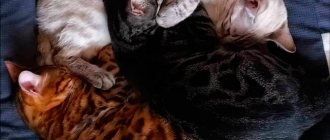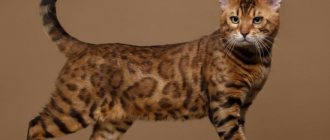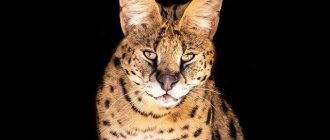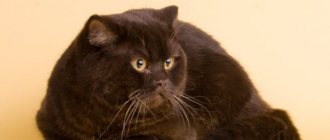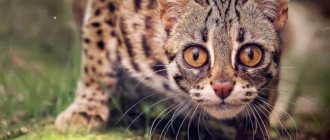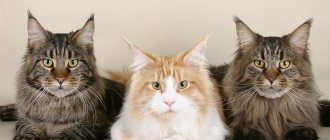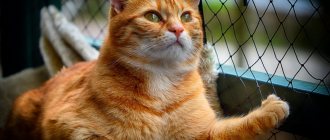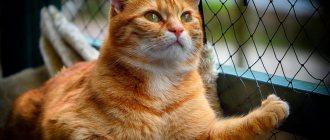Coat and color are a distinctive feature of the Bengal cat. Each pattern is individual: spots or stripes on a cat are like fingerprints on a person; no two are alike. Today, there are many colors of Bengal cats. The Snow Bengal stands out among all of them; it is even sometimes confused with another breed. Every cat lover dreams of having a little “leopard” at home.
Color standards
Outwardly, the Bengal cat always resembles its wild ancestors. On the muzzle there are contrasting dark stripes that resemble the letter “M” on the forehead. Light-colored whisker pads. The contours of the nose, lips and eyes are black or darker. Dark stripes on the neck, like a necklace, decorate it. There are often small stripes on the paws, but there may also be spots. The tail is also spotted or rosette, but its tip always remains black. All breeders strive to get as close as possible to the appearance of a wild cat. Therefore, the spotted belly and chest should preferably be lighter. It is not always possible to achieve such selective lightening - scientists still cannot definitively determine the gene that is responsible for this.
The colors of Bengals are distinguished by the color of the background and the type of pattern that is located on it. The most common are gold and silver backgrounds. There are snow bengals, among which there are lynx, mink, and sepia. The charcoal color is considered more rare. The blue color is also officially recognized.
The rarest colors
Blue and black bengals are not yet recognized by the International Feline Association, but due to their interesting colors, they are popular.
Melanistic
This is a black Bengal with a subtle pattern. Panthers wear coats of this color in nature. A newborn kitten has a standard patterned color, and the darkening of the fur of a melanistic Bengal is observed in adulthood.
Ash or charcoal color
This type of color belongs to the brown tabby, but is characterized by a cooler, lighter tone of the base background. The large pattern on the body and muzzle is jet black.
The cat's eyes are outlined with a light stripe, giving the impression that the animal is wearing glasses. The black color today does not have official recognition and is not included in the standard, although it is very popular among Bengals.
Blue
BEN a 24. Very rare coloring of a non-standard type. The color of the skin is grey-blue, with a slight peach tint in the chest area. The pattern is patterned, gray in color. Felinologists have recognized this color as official.
Other
There are Bengals of other original colors:
- solid black;
- solid chocolate;
- lilac;
- tortoiseshells.
But Bengal cats with such colors are rare and are considered defective: they have no exhibition value and are not used in breeding.
Pattern: spotted or marbled
Cat coloring is divided into two types:
- Spotted (from English spotted) or rosette (from English rosetted) pattern. In the first case, these are solid spots. In the second, the so-called sockets. The color inside the rosette should be darker than the background, which is completely or partially surrounded by a darker circle (closed and open rosette). The size of the spots or rosettes can range from small to large.
- Marble (from English marbled) pattern: represents various horizontal stripes. Circular or vertical marks are faults. It is more highly valued when the marble pattern of the Bengal contains three colors: the background shade, the pattern and its edging.
To distinguish the colors of Bengal cats, it is easier to use the table:
Care and feeding of Bengals
A short-haired cat brings less worries at home than its long-haired counterparts, which makes caring for your pet much easier. Keeping and caring for a cat is not difficult: 2-3 times a week, devote a little time to combing the fur, which a soft rubber brush will help with. Sometimes you may not even notice the shedding, but once the procedure has begun, it is better to comb the kitty more often.
The descendant of a wild leopard cat needs to trim its claws once every couple of weeks. The ears are cleaned at the same intervals with a damp cotton pad.
It is also necessary to take care of your pet's oral cavity by brushing its teeth once a week.
The bath easily becomes a favorite place for the Bengal, who happily hits the water with his paws. Washing is allowed in rare cases using special cat shampoos.
Feeding a Bengal kitten occurs from month to month according to the feeding schedule and recommendations of specialists. Good nutrition quickly turns a small cat into a healthy, strong cat.
What to feed a Bengal kitten for 2 months
They also feed raw meat (beef or rabbit), exclude raw offal from the diet, replacing them with boiled sea fish once a week. Dairy products in the form of kefir, baby cottage cheese without any additives, and low-fat cream are useful for cats. The daily food intake also involves the addition of vegetables not exceeding a quarter of the volume of meat products. These are carrots, tomatoes, bell peppers. A Bengal cat can be switched to premium and super premium dry food, which the animals eat with benefit and pleasure.
Keeping a neutered cat involves replacing natural nutrition with specialized food.
Snow Bengal
Snow color is one of the rare ones. Snow Bengal kittens are divided into three groups depending on their genotype.
Links (Ben n 33) The background is represented by shades of cream or ivory. The pattern varies in tones of brown from light to dark. The head and paws are darker than the body. The tail is brown. These are the only snow bengals that are born completely white, and the pattern does not appear until they are one year old.
Mink (Ben n 32) They are often confused with the link color. The drawing from birth practically merges with the background and is hardly noticeable. The main difference is the eyes: their color varies from bright green to blue.
Sepia (Ben n 31) The color is lighter than golden, but darker than other snow Bengal cats. The difference between the background and the picture is small. The pads on the paws are brown, as is the tip of the tail. Eye colors include variations of green and yellow.
Features of phasing of brown tabby kittens
Phasing is a special phenomenon that domestic Bengals inherit from wild Asian Leopard Cats (ALC). It manifests itself in Bengal kittens, regardless of the distance of its ancestry from forest ancestors. The term “Fuzzy” from English “vague, shaded” accurately defines the essence of the natural process of masking spots. By the age of one month, kittens grow long, thin hair that hides bright markings. By about 4-5 months, babies' phasing hair falls out. On spotted young animals, the coloring appears faster, but in the marble variety, the streaks develop more slowly - the marbled cat finally blooms only at two years of age.
The unusual and fascinatingly intricate patterns of brown tabby fur coats determine the popularity of the young breed, which is in the stage of active development. It is brown Bengals, especially such an attractive rosette on gold, that occupy the highest level in the demand ratings.
Mixed bengal cat
Bengals are prohibited from crossing with other cat breeds. This is fraught with sick or completely non-viable offspring. However, some engage in this activity for commercial purposes. Such kittens can be found through frequent advertisements on the Internet. We warn you! Mixed breeds of the Bengal cat are not officially recognized. Such kittens do not belong to the Bengal breed. As a result, you can get a kitten that will not meet external standards, but also its character. Breeders carefully select affectionate and non-aggressive representatives. Otherwise, the genes may take over and you will end up with an uncontrollable animal. Long-haired mixed breed (cashmere bengal, silk bengal) is gaining popularity. The animal has a similar color. It is distinguished by a fluffy tail, a “collar”, and longer hair on the sides and back.
About the famous sparkler glitter
From English glitter translates as shine, flicker, radiance. All these “sparkling” definitions are suitable in describing the effect on the surface of the coat, which was noticed and successfully fixed in Bengal cats. In sunlight, there is an impression that rays are reflected from the hairs, like from mirror needles. The peculiarity is not inherent in all representatives of the breed, and its origins are from a tailless (trampled by rhinoceroses) kitten named Delhi, brought from India by Gina Mill and became a pair of hybrid Bengal brides.
There are two explanations for the glitter effect at the hypothesis level. Several different assumptions interpret this phenomenon.
- The characteristic shine is controlled by a special recessive gene, which in its homozygous state leads to a certain grouping of pigment granules on the hairs. As a result, the texture of the wool does not change, and the surface of the hairs begins to reflect light.
- In another version, this gene, being in a homozygous state, thins out pigment granules. As a result, microscopic air bubbles are formed, which... catch rays by refracting light. Proponents of this hypothesis are confident that the same gene gives softness and silkiness to the hair. The glitter effect gives classic coat colors a golden shine, and light silver Bengals a pearly sheen.
Unrecognized colors
In addition to the standard color of Bengals, there are new options that have not yet received recognition:
- Carbonic. The type resembles silver, but the base tone is much darker. The clearly defined black pattern has no blur and is clearly visible against a gray or ashy background. The general color palette is cold. The nose of the Charcoal Bengal is black, and there is a light edging around the eyes.
- Melanistic. The almost monochromatic black Bengal cat with a faintly visible pattern belongs to this color. A kitten is born with a normal contrasting pattern, which with age completely covers up the glitter. Occasionally, melanistic Bengals may be a different color.
- Blue. This color option is characterized by a less bright pattern of bluish-gray color with a metallic sheen. The pattern consists of large rosettes or spots. The background of the coat is bluish-gray on the back and soft peach on the belly. The Blue Bengal cat is extremely rare.
Common colors
Of the huge number of types of colors, nature gave these small wild predators only one - “black spotted tabby”, and it is ideal for high-quality camouflage in a wild environment. The coat can have colors from delicate sand and gray to the darkest chestnut - this depends on the cats’ habitat. At the same time, the process of hybridization brought its own changes to the Bengal breed, and very interesting varieties appeared in the standards.
The TICA standard distinguishes 5 different colors. All of them, according to genetics, are black in color, but due to the increased degree of rufism, the color of cats often looks like yellowish-brown, leopard. That's why these colors are called:
- brown spotted marble tabby;
- silver spotted marble tabby;
- seal sepia spotted marble tabby;
- seal mink spotted marble tabby;
- seal spotted marble lynx-point.
In all of the above colors, experts allow the 2 types of patterns described above. In addition, a number of standards take into account blue colors. In this case, there can be combinations of all 4 listed colors and 2 patterns with silver wool.
Sometimes breeders produce completely black cats (melanistic), chocolate-colored kittens, and even lilac cats with tortoiseshell colors.
But these colors are not yet considered correct, therefore such cats are not used for breeding.
It is the brown tabby that is considered the original variety of the modern Bengal breed. The wild cat Malaysia once had a similar color, which was crossed with the Abyssinian black cat. The spots and stains (and plain ones too) in their descendants can be completely black, with a transition to a dark chocolate shade, or brick-brown, and even with a yellowish-brown tint.
